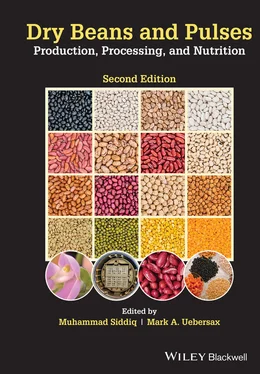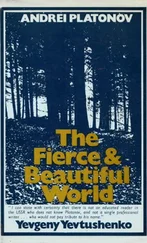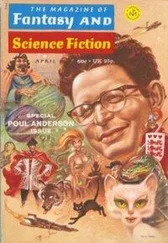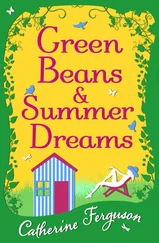Dry Beans and Pulses Production, Processing, and Nutrition
Здесь есть возможность читать онлайн «Dry Beans and Pulses Production, Processing, and Nutrition» — ознакомительный отрывок электронной книги совершенно бесплатно, а после прочтения отрывка купить полную версию. В некоторых случаях можно слушать аудио, скачать через торрент в формате fb2 и присутствует краткое содержание. Жанр: unrecognised, на английском языке. Описание произведения, (предисловие) а так же отзывы посетителей доступны на портале библиотеки ЛибКат.
- Название:Dry Beans and Pulses Production, Processing, and Nutrition
- Автор:
- Жанр:
- Год:неизвестен
- ISBN:нет данных
- Рейтинг книги:5 / 5. Голосов: 1
-
Избранное:Добавить в избранное
- Отзывы:
-
Ваша оценка:
- 100
- 1
- 2
- 3
- 4
- 5
Dry Beans and Pulses Production, Processing, and Nutrition: краткое содержание, описание и аннотация
Предлагаем к чтению аннотацию, описание, краткое содержание или предисловие (зависит от того, что написал сам автор книги «Dry Beans and Pulses Production, Processing, and Nutrition»). Если вы не нашли необходимую информацию о книге — напишите в комментариях, мы постараемся отыскать её.
The second edition of the most complete and authoritative reference on dry beans production, processing, and nutrition available Dry Beans and Pulses: Production, Processing, and Nutrition
Dry Beans and Pulses: Production, Processing, and Nutrition, Second Edition
Dry Beans and Pulses Production, Processing, and Nutrition — читать онлайн ознакомительный отрывок
Ниже представлен текст книги, разбитый по страницам. Система сохранения места последней прочитанной страницы, позволяет с удобством читать онлайн бесплатно книгу «Dry Beans and Pulses Production, Processing, and Nutrition», без необходимости каждый раз заново искать на чём Вы остановились. Поставьте закладку, и сможете в любой момент перейти на страницу, на которой закончили чтение.
Интервал:
Закладка:
61 Kelly, J.D., Gepts, P., Miklas, P.N. & Coyne, D.P. (2003). Tagging and mapping of genes and QTL and molecular marker‐assisted selection for traits of economic importance in bean and cowpea. Field Crops Research 82: 135–154.
62 Kelly, J.D., Kolkman, J. & Schneider, K. (1998). Breeding for yield in dry bean (Phaseolus vulgaris L.). Euphytica 102: 343–356.
63 Kelly, J.D. & Miklas, P.N. (1998). The role of RAPD markers in breeding for disease resistance in common bean. Molecular Breeding 4: 1–11.
64 Kelly, J.D. & Vallejo, V.A. (2004). A comprehensive review of the major genes conditioning resistance to anthracnose in common bean. HortScience 39: 1196–1207.
65 King, H.B., Rissing, A. & Chuvileva, Y.E. (2021). People of the Bean. Anthropology News – Available at https://www.anthropology‐news.org/index.php/2021/01/08/people‐of‐the‐bean/(accessed April 3, 2021).
66 Koinange, E.M.K., Singh, S.P. & Gepts, P. (1996). Genetic control of the domestication syndrome in common bean. Crop Science 36:1037–1045.
67 Kornegay, J., White, J.W. & Ortiz de la Cruz, O. (1992). Growth habit and gene pool effects on inheritance of yield in common bean. Euphytica 62: 171–180.
68 Kusolwa, P.M., Myers, J.R., Porch, T.G., Trukhina, Y., González‐Vélez, A. & Beaver, J.S. (2016). Registration of AO‐1012‐29‐3‐3A red kidney bean germplasm line with bean weevil, BCMV, and BCMNV resistance. Journal of Plant Registrations 10: 149–153.
69 Liebenberg, M.M. & Pretorius, Z.A. (2010). Common bean rust: Pathology and control. Horticultural Reviews 37: 1–99.
70 Martin, G.B. & Adams, M.W. (1987). Landraces of Phaseolus vulgaris L. in northern Malawi. I. Regional variation. Economic Botany 41: 191–203.
71 Maxfield, L. & Crane, J.S. (2020). Zinc deficiency. Available at https://www.ncbi.nlm.nih.gov/books/NBK493231/(accessed April 2, 2021).
72 Mendoza, F. A., Kelly, J. D. & Cichy, K. A. (2017). Automated prediction of sensory scores for color and appearance in canned black beans (Phaseolus vulgaris L.) using machine vision. International Journal of Food Properties 20: 83–99.
73 Miklas, P.N., Fourie, D., Trapp, J., Davis, J. & Myers, J.R. (2014). New loci including Pse‐6 conferring resistance to halo bacterial blight on chromosome Pv04 in common bean. Crop Science 54: 2099–2108.
74 Miklas, P.N., Kelly, J.D., Beebe, S.E. & Blair, M.W. (2006). Common bean breeding for resistance against biotic and abiotic stresses: From classical to MAS breeding. Euphytica 147: 105–131.
75 Miklas, P.N., Osorno, J.M., Chaves, B. & Cichy, K.A. (2020) Agronomic performance and cooking quality characteristics for slow‐darkening pinto beans. Crop Science 60: 2317–2327.
76 MSU (Michigan State University). (2009). One Hundred Years of Bean Breeding at Michigan State University: A Chronology. Available at https://www.canr.msu.edu/uploads/files/Research_Center/Saginaw_Valley/100YrsMSUBeanBreeding.pdf(accessed March 23, 2021).
77 Naderpour, M., Lund, O.S., Larsen, R. & Johansen, E. (2010). Potyviral resistance derived from cultivars of Phaseolus vulgaris carrying bc‐3 is associated with the homozygotic presence of a mutated eIF4E allele. Molecular Plant Pathology 11: 255–263.
78 NRC (National Research Council, U.S.). (1972). Genetic vulnerability of dry beans. In: Genetic Vulnerability of Major Crops (pp. 224–234). Washington, DC: National Academy of Sciences.
79 Oladzad, A., González, A., Macchiavelli, R., de Jensen, C. E., Beaver, J., Porch, T. & McClean, P. (2020). Genetic factors associated with nodulation and nitrogen derived from atmosphere in a middle American common bean panel. Frontiers in Plant Science 11: 576078.
80 Pallottini, L., Garcia, E., Kami, J., Barcaccia, G. & Gepts, P. (2004). The genetic anatomy of a patented yellow bean. Crop Science 44: 968–977.
81 Paredes, M.C., Becerra, V.V. & Tay, J.U. (2009). Inorganic nutritional composition of common bean (Phaseolus vulgaris L.) genotypes race Chile. Chilean Journal of Agricultural Research 69: 486–495.
82 Parker, T., Palkovic, A., Brummer, E. C. & Gepts, P. (2021a). Registration of ‘UC Rio Zape’ heirloom‐like dry bean. Journal of Plant Registrations 15: 37–42.
83 Parker, T., Palkovic, A., Brummer, E. C. & Gepts, P. (2021b). Registration of ‘UC Tiger's Eye’ heirloom‐like dry bean. Journal of Plant Registrations 15: 16–20.
84 Parker, T., Palkovic, A., Brummer, E. C. & Gepts, P. (2021c). Registration of ‘UC Southwest Red’ heirloom‐like red and white mottled bean. Journal of Plant Registrations 15: 21–27.
85 Parker, T., Palkovic, A., Brummer, E. C. & Gepts, P. (2021d). Registration of ‘UC Southwest Gold’ heirloom‐like gold and white mottled bean. Journal of Plant Registrations 15: 48–52.
86 Parker, T., Palkovic, A., Brummer, E. C. & Gepts, P. (2021e). Registration of ‘UC Sunrise’ heirloom‐like orange and white mottled bean. Journal of Plant Registrations 15: 43–47.
87 Peng, S., Huang, J., Cassman, K.G., Laza, R.C., Visperas, R.M. & Khush, G.S. (2010). The importance of maintenance breeding: A case study of the first miracle rice variety‐IR8. Field Crops Research 119: 342–378.
88 Polania, J.A., Poschenrieder, C., Beebe, S. & Rao, I.M. (2016). Effective use of water and increased dry matter partitioned to grain contribute to yield of common bean improved for drought resistance. Frontiers in Plant Science 7: 660.
89 Porch, T.G., Smith, J.R., Beaver, J.S., Griffiths, P.D. & Canaday, C.H. (2010). TARS‐HT1 and TARS‐HT2 heat‐tolerant dry bean germplasm. HortScience 45: 1278–1280.
90 Porch, T.G., Beaver, J.S., Debouck, D.G., Jackson, S.A., Kelly, J.D. & Dempewolf, H. (2013). Use of wild relatives and closely related species to adapt common bean to climate change. Agronomy 3: 433–461.
91 Raatz, B., Mukankusi, C., Lobaton, J.D., Male, A., Chisale, V., Amsalu, B., Fourie, D., Mukamuhirwa, F., Muimui, K., Mutari, B. & Nchimbi‐Msolla, S. (2019). Analyses of African common bean (Phaseolus vulgaris L.) germplasm using a SNP fingerprinting platform: diversity, quality control and molecular breeding. Genetic Resources and Crop Evolution 66: 707–722.
92 Reinprecht, Y., Schram, L., Marsolais, F., Smith, T.H., Hill, B. & Pauls, K.P. (2020). Effects of nitrogen application on nitrogen fixation in common bean production. Frontiers in Plant Science 11: 1172.
93 Richard, M., Gratias, A., Alvarez Diaz, J.C., Thareau, V., Pflieger, S., Meziadi, C., Blanchet, S., Marande, W., Bitocchi, E., Papa, R. & Miklas, P.N. (2021). A common bean truncated CRINKLY4 kinase controls gene‐for‐gene resistance to the fungus Colletotrichum lindemuthianum. Journal of Experimental Botany 72: 3569–3581.
94 Rodrigues, L.L., Rodrigues, L.A., de Souza, T.L., Melo, L.C. & Pereira, H.S. (2019). Genetic control of seed coat darkening in common bean cultivars from three market classes. Crop Science 59: 2046–2054.
95 Saltzman, A., Birol, E., Oparinde, A., Andersson, M.S., Asare‐Marfo, D., Diressie, M.T., Gonzalez, C., Lividini, K., Moursi, M. & Zeller, M. (2017). Availability, production, and consumption of crops biofortified by plant breeding: current evidence and future potential. Annals of the New York Academy of Sciences 1390: 104–114.
96 Schmutz, J., McClean, P.E., Mamidi, S., Wu, G.A., Cannon, S.B., Grimwood, J., Jenkins, J., Shu, S., Song, Q., Chavarro, C. & Torres‐Torres, M. (2014). A reference genome for common bean and genome‐wide analysis of dual domestications. Nature Genetics 46: 707–713.
97 Schröder, S., Mamidi, S., Lee, R., McKain, M.R., McClean, P.E. & Osorno, J.M. (2016). Optimization of genotyping by sequencing (GBS) data in common bean (Phaseolus vulgaris L.). Molecular Breeding 36: p.6.
98 Schwartz, H.F. & Singh, S.P. (2013). Breeding common bean for resistance to white mold: a review. Crop Science 53: 1832–1844.
Читать дальшеИнтервал:
Закладка:
Похожие книги на «Dry Beans and Pulses Production, Processing, and Nutrition»
Представляем Вашему вниманию похожие книги на «Dry Beans and Pulses Production, Processing, and Nutrition» списком для выбора. Мы отобрали схожую по названию и смыслу литературу в надежде предоставить читателям больше вариантов отыскать новые, интересные, ещё непрочитанные произведения.
Обсуждение, отзывы о книге «Dry Beans and Pulses Production, Processing, and Nutrition» и просто собственные мнения читателей. Оставьте ваши комментарии, напишите, что Вы думаете о произведении, его смысле или главных героях. Укажите что конкретно понравилось, а что нет, и почему Вы так считаете.












